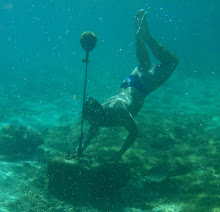
Earlier in the year I was out twitching the Wandering Tattler at Long Reef - as was the rest of Sydney. Long Reef is prime wader and Mark Young habitat, if you have not yet seen Mark's blog about the life around Long Reef, then press here or follow the link in the "My Blog List" to the right.

I had once again teamed up with Jarrod, who is normally an excellent early starter, but this Saturday we managed to truly mess up when we decided to begin our journey midday - making your way to the northern beaches through Sydney traffic a Sunday midday is less fun than filing your tax return and it takes longer time!

Well, after some very slow driving we finally arrived and eagerly pushed up the hill to overlook the reef. For some reason it felt like the entire world had decided to make this day a struggle for us - in reality all our troubles were probably self-inflicted due to exceptional bad planning - not only was it high tide and the reef flooded, just as we reached the top of the hill it started raining cats and dogs! In combination with the howling winds from the east, long reef did in no way look like a place to to spend a Sunday afternoon and attempting to find a dark Wandering Tattler in these conditions seemed a little foolish.

Somehow we had to justify a nearly 3 hours drive through Sydney traffic and we went down to inspect the tiny area of the reef that was still accessible. A few common birds where scattered around on the sand and rocks, but after a quick inspection we got alerted to the presence of a few exciting blue creatures caught in the shallow waters surrounding the reef.

A first for me was the incredible beautiful Glaucus atlanticus, aka blue sea slug. Not a large creature, but one of the prettiest water living characters I have seen during my time in Australia.

We saw quite a good number of these small blue gems of the ocean and a fearless Jarrod even assisted a couple of the stranded ones in making their way back to deeper water. Indeed us humans should do what we can to help this blue nudibranch, since its main food source is Blue Bottle, Physalia utriculus, and blue button, Porpita porpita - see the photos below. Both of these blue stingers are common around Sydney and the sting of the blue bottle in particular is an unpleasant experience that many Sydneysiders will have to endure when swimming in the sea on summer days with a easterly blowing. When the Glaucus atlanticus eats its victims it is capably of storing the most poisonous parts of its food and up concentrate the venom in the very tip of its "fingers". The means that the Glaucus atlanticus can deliver an even more vicious sting than the stingers it feeds on .. I am not sure Jarrod knew that when he volunteered to model in the photo above :-D


Feeling our luck changing after the success with the Glaucus atlanticus we once again started considering if there was indeed a chance of seeing the Wandering Tattler – the reason we drove to Long Reef in the first place. If the bird was still at the reef it would clearly have searched refuge at the still exposed rocky section now separated from the mainland by a ca. 100 meters flooded area … well that was there the bird was, then that was where we had to go to see it!

Luck follows the crazy – Danish saying “held følger de tossede” – Arriving at the rocky outcrop there was at first nothing indicating that we would be able to see or even less likely get decent pictures of the Wandering Tattler, weather had worsened, it had started raining again, that does not matter much when you are soaking wet up till above your knees, but the exposed reef was also significantly more windy than it had been ashore and I had nearly given up, when a tattler looking bird suddently took off from a sheltered part of the reef where we would have had no chance to see it if I had decided to stay.


It looped up and around the southern end of the reef and for a couple of seconds it looked like it was aiming at landing at our feet, just towards the end of its approach it seemed to suddenly realize that a couple of humans had entered its habitat and it broke off the approach and landed on a rock few meters away – There was our Wandering Tattler slightly confused a few meters in front of us, “wandering” up and down the rock as a model on the red carpet – Luck did indeed follow the ones with wet feet this Sunday afternoon at Long Reef.

All good, we got much more out of this rainy Sunday afternoon than we deserved and a new bird significantly adds to the joy of driving home through Sunday afternoon Sydney traffic.











